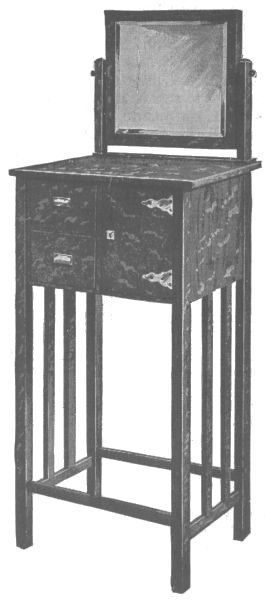While this piece of furniture can be made in any kind of wood, the novice will find that quarter-sawed
oak will work up and finish better than the other woods. The stock list given has dimensions 1/2 in.
larger in some instances for dressing and squaring where necessary.
The tenons and mortises are first cut for the crosspieces at the bottom of the posts, and, as it is
best to use dowels at the top, holes are bored in the
bottom piece and also the ends of the slats for pins. The bottom piece is also fastened to the posts with
dowels. The bottom must have a square piece cut out from each corner almost the same size as the
posts. When setting the sides together the end board and posts can be doweled and glued together and after drying well the posts can be spread apart
far enough to insert the bottom rail and two slats. The rail and slats should be tried for a bit before
putting on any glue, which may save some trouble.
 Shaving Stand Complete
Shaving Stand Complete
After the sides are put together, the back is put in and glued. The top is then put on and fastened with cleats from the inside. The partitions
are put in as shown and the door fitted. Two drawers are made from the ends and the soft wood material. The drawer ends may be supplied with
wood pulls of the same material or matched with metal the same as used for the hinges.
The pieces for the mirror frame must be rabbeted 1/2 in. deep to take
the glass, and the ends joined together with a miter at each corner. The
two short posts are tenoned and mortises cut in the bottom piece for
joints and these joints well glued together. The bottom piece is then
fastened to the top board of the stand. This will form the standards in
which to swing the mirror and its frame. This is done with two pins
inserted in holes bored through the standards and into the mirror frame.
After the parts are all put together, cleaned and sandpapered, the stand is ready for the finish.



 Shaving Stand Details
Shaving Stand Details
 Mirror Frame and Standards Details
Mirror Frame and Standards Details